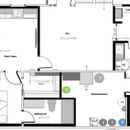Confused in NC about Mechanical Room Air and Insulation Requirements
I purchased and have nearly completed the remodel of a 1972 brick ranch in Raleigh, NC with west-facing daylight basement (on the back and one side). During the upstairs remodel I installed continuous drywall walls and ceiling before installing new interior-walls. For existing walls I used spray foam in the attic to air seal them. Downstairs I caulked and insulated rim joists and followed the steps in https://www.greenbuildingadvisor.com/article/installing-rigid-foam-concrete-slab to insulate and air seal the walls and floor. Where I had load-bearing walls bearing on concrete, I sealed the sill to the floor with “big stretch” caulk. I thought I had done the best I could considering the age of my house; however, I think, I have failed in the mechanical room and can use some advice please. I have not installed any XPS on the one exterior wall in the mechanical room or the concrete floor (slab only has vapor under the 4” concrete.) I’ve not considered the floor in this room because some of it has vinyl flooring on it and all the appliances are sitting directly on the concrete – direct vent furnace, heat pump H20 tank and well water treatment tanks. I’m trying to understand what I need to do to properly treat this as space inside my building envelop – air seal and insulation. I spoke the company I used to blow insulation in the attic and they told me I need to either insulate the walls between the mechanical room and the finished space above, install a 6 mill plastic-type barrier over that and insulate all the water lines or they could spray it all with foam. Does that sound right? Advice on how to properly manage this to keep this in my building envelop and not end up with an airtight musty room would be more than appreciated.
GBA Detail Library
A collection of one thousand construction details organized by climate and house part










Replies
What you're saying sounds like you're trying to keep the mechanical room OUTSIDE of the building envelope, but you also said you WANT to keep it INSIDE the building envelope. I'm a bit confused as to what you're trying to do here.
My recommendation would be to keep the mechanical room INSIDE the building envelope. To do this, you want to seal the exterior wall the same way you would any other exterior wall, and you wouldn't need to seal the interior walls since the building envelope is defined by the exterior walls (in this case), and probably the attic floor (which will also be the ceiling of the uppermost level of the house).
You want to think of the building envelope as a barrier between the interior and the exterior of the home. Make sure it is continuous without any gaps and you're in good shape. You don't necassarily need to seal the concrete floor itself, but if you want to, epoxy floors work for this purpose -- but you need to start with a clean slab.
Bill
thank you so much for the prompt reply Bill! I definitely want to keep in inside the envelop and felt the advise (bid) I was getting from the insulation company was putting it outside my building envelope. I had extra rockwool insulation from the house that I was saving to put in the mechanical room exterior wall. After speaking to the insulation company I'd put it in the wall between the closet and bathroom and the mechanical room. I should take it down from there, install the XPS on the exterior wall (per your post) and then put it in the stud wall I'll need against the XPS for the pluming manifold correct? That was the original plan I had for it. Thank you again.
You generally only put insulation in interior walls for one of two reasons:
1- Sound attenuation. This actually makes a lot of sense for a mechanical room, especially one near sleeping and living spaces. I'd put mineral wool in those intererior walls to try to limit how much you hear things like your furnace running.
2- When you have two rooms that will be kept at different temperatures, which in residential systems usually means between sleeping and living zones. Commerically it's more common, for example I have to maintain battery rooms at a higher temperature than data center floor space, so I insulate the walls of the battery room.
Insulation acts to slow the transfer of thermal energy, which is how it gains you energy efficiency. If you have both sides of the wall at the same temperature, and sound isn't an issue, there is no reason to insulate the wall.
You DO want to insulate EXTERIOR walls since you will generally be keeping your home at a different temperature than the outdoors. Use XPS if you already have it, otherwise consider using polyiso instead. Then insulate the stud cavities to have at least as much insulation as the rest of the exterior walls of the home. You want to make sure your plumbing is INSIDE the home too, so you don't want to put insulation between the pipes and the interior of the home -- doing so would increase the risk of pipes freezing in the winter.
It does sound like your insulating company would put the mechanical room outside of the building envelope. This is a bad idea, you want to keep that stuff INSIDE for best efficiency. You don't want to insulate the ceiling of that room, either, if there is living space above it, unless you're trying to limit sound transmission. If there is attic space above it, then you probably do want to insulate that ceiling unless you have a conditioned attic.
Bill
Thank you! I will use polyiso.